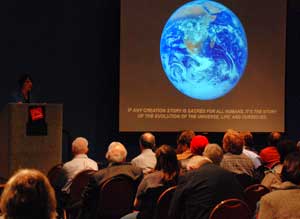April 7, 2008
View From the Center of the Universe: Discovering Our Extraordinary Place in the Cosmos
Connecting matters of cosmic significance with the environment and the fate of human life on planet Earth
COLLEGE PARK, MD – Bestselling authors Joel Primack and Nancy Abrams offer a tour of the ways traditional cultures have sought to explain not only the mechanism of the universe but its meaning to humans. As one of the world's leading cosmologists and an originator and developer of the theory of Cold Dark Matter, now accepted as the standard theory of the structure and evolution of the universe, Primack possesses the scientific credentials to explain the complex science underlying the newly emerging picture of the universe. Combining his expertise with Abrams's wide-ranging scholarship in the history of science and the arts, they explore how meaning can be found in the new information coming in daily from the heavens. Together they present new ways to approach this cascade of information and its implications for our planet, offering a picture of the universe for our time. Their talk contains spectacular astronomical videos and is accessible to listeners whether they have any scientific background or not.
In considering the common need among humans to conceptualize their cosmologies, Primack and Abrams have figured out how to visually communicate the fundamental characteristics of the new universe. They have redefined familiar images and ancient metaphors into a modern series of symbols that illustrate cutting-edge scientific understandings and theories. What each symbol shows graphically could not be more surprising or profound – human beings are, against all modern intuition, central to the expanding universe in at least seven ways that are not anthropocentric but arise out of the laws of physics – “central,” that is, not geographically but in ways Copernicus and those who followed never suspected. In discussing concepts that range from dark matter and size scales to dark energy and more, they use their symbols to help clarify what is now known about how the universe may have begun, what it is made of, how it works, and how humans and earth fit into the larger picture and larger story of the cosmos.
Primack and Abrams persuasively make the case that understanding the nature of our universe has profound implications for everyone here on earth, not just those engaged in research, because the universe is not just “out there” – it’s here. The ecological as well as financial and political balances in our own world, and the challenge of stewarding our planet through the coming end of explosive growth, are re-envisioned through the prism of their brilliant synthesis. Their goal is to help this generation and those in the future to use this new knowledge to expand our perspectives and protect the long-term well-being of our planet and our descendants. With the principle "Think Cosmically, Act Globally," Primack and Abrams build a new foundation for understanding this complex science and its inextricable earthly ties.
~ ~ ~
Primack and Abrams are coauthors of the best-selling book, The View from the Center of the Universe: Discovering Our Extraordinary Place in the Cosmos.
Joel R. Primack, Professor of Physics at the University of California, Santa Cruz, specializes in the formation and evolution of galaxies and the nature of the dark matter that makes up most of the matter in the universe. After helping to create what is now called the “Standard Model” of particle physics, he began working in cosmology in the late 1970s and he became a leader in the new field of particle astrophysics. Primack’s research in cosmology is described in most modern books on the subject, and he has been profiled at some length in several books including New York Times science writer Dennis Overbye's Lonely Hearts of the Cosmos and Time magazine science editor Michael Lemonick’s The Light at the Edge of the Universe. In addition to more than 200 technical articles in professional journals, Primack has written a number of articles aimed at a more popular audience. These include the articles on “gravitation,” “matter,” “dark matter,” “dark energy,” and other physics and astronomy topics in the World Book Encyclopedia, and articles in publications such as Astronomy, Beam Line, California Wild, Sky and Telescope, and in the McGraw-Hill Encyclopedia of Science and the Encyclopedia of Astronomy and Astrophysics.
Nancy Ellen Abrams received her B.A. in the history and philosophy of science from the University of Chicago, her J.D. from the University of Michigan, and a diploma in international law from the Escuela Libre de Derecho in Mexico City. She was a Fulbright Scholar and a Woodrow Wilson Designate. She is a writer whose work has appeared in journals, newspapers, and magazines, such as The Bulletin of the Atomic Scientists, Environment, California Lawyer, Science and Global Security, and Tikkun. She has a long-term interest in the role of science in shaping a new politics and has worked in this area for a European environmental think tank in Rome, the Ford Foundation, and the Office of Technology Assessment of the U.S. Congress, where she co-invented (with R. Stephen Berry of the National Academy of Sciences) a novel procedure called “Scientific Mediation.” Abrams is also a songwriter who has performed at conferences, concerts, and events in eighteen countries, released three albums, and been featured on National Public Radio and television.

Brian Mosley/APS
Public lecture at the St. Louis Science Center by Joel Primack and Nancy Ellen Abrams, authors of View from the Center of the Universe. Dr. Abrams shown.
About APS
The American Physical Society is a nonprofit membership organization working to advance and diffuse the knowledge of physics through its outstanding research journals, scientific meetings, and education, outreach, advocacy, and international activities. APS represents more than 50,000 members, including physicists in academia, national laboratories, and industry in the United States and throughout the world.
